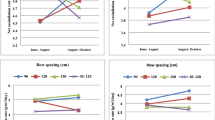Abstract
In India, the ratoon cane productivity at national level stands at 58 t/ha against 85 t/ha for plant cane. Ratooning is a practice of growing full crop of sugarcane from sprouts of underground stubble buds left in the field after harvest of the plant (main) crop. In sugarcane farming, ratooning saves the cost of seedbed preparation, seed material and planting operations. Ratoons help in extending the crushing period of sugar mills as they mature earlier than the plant crop. However, most often, ratoon crop yields are lower than the plant crop. The major cause of low ratoon cane productivity in north-west Indian subtropics is the prevalence of severe winter conditions coinciding with harvesting of early-maturing high sugar varieties which inhibit the sprouting of subterranean stubble buds. Unsprouted stubble buds cause gaps in subsequent sugarcane (Saccharum sp Hybrid) ratoon crop resulting in lower initial plant stand and poor crop yield. Several agro-techniques viz., trash mulching, polyethylene mulching and intercropping have been applied to enhance the bud sprouting in winter-initiated ratoon, but all the efforts could not produce the desired results. To address these constraints, a field experiment was conducted during 2009–2010 and 2010–2011 for three consecutive seasons at the Indian Institute of Sugarcane Research, Lucknow, India, to assess the effect of cultural package practices and organic and/or inorganic sources of additions on yield and quality of winter-initiated ratoon in Indian subtropics. Results thus showed that application of sulphitation press mud cake (SPMC) at 20 t/ha or SPMC at 10 t/ha + 25 kg zinc sulphate improved the bud sprouting and significantly produced maximum number of shoots. Significant increase in the number of millable canes was noticed with the application of SPMC at 20 t/ha (103.1 thousand/ha) and SPMC 10 t/ha + 25 kg ZnSO4 (102.1 thousand/ha). Maximum cane yield (71 t/ha) was also recorded with the application of SPMC at 20 t/ha followed by SPMC at 10 t/ha + 25 kg ZnSO4 (69.3 t/ha). Thus, it clearly suggests that productivity of winter-initiated ratoon can be enhanced through the application of SPMC at 20 t/ha or SPMC 10 t/ha + 25 kg ZnSO4/ha since these applications at the time of ratoon initiation enhanced the ratoon cane yield by 16.34 and 14.29 %, respectively, than that of conventional package of practices for ratoon initiation in subtropical climatic conditions of India. Juice quality of ratoon cane was remained unchanged.
Similar content being viewed by others

References
Angers, D.A., A. Pesant, and J. Vigneux. 1992. Early cropping induced changes in soil aggregation organic matter and microbial biomass. Soil Science Society of America Journal 56: 115–119.
Doran, J.W., Coleman D.C., Bezdicek, D.F. and Stewart, B.A. (eds.). 1994. Defining Soil quality for a sustainable environment, SSSA Special Publication No. 35. Soil science society of America, Inc. and the American society of agronomy, pp. 3–21. Madison, WI
Haynes, R.J., R.S. Swift, and R.C. Stephen. 1997. Influence of mixed cropping rotations (pasture arable) on organic matter content stable aggregation, and clod porosity in a group of soils. Soil and Tillage Research 19: 77–87.
Kanwar, R. and Kaur, S.H. 1981. Further studies on improving productivity of stubble crops in low temperate area of north India. In Proceedings of national seminar on ratoon management, pp. 27–34. Lucknow
Lal, M. and Singh, A.K. 2008. Multiple ratooning for high cane productivity and sugar recovery. In Proceedings of national seminar on varietal planning for improving productivity and sugar recovery in sugarcane, pp. 62–68.
Miller, R.M., and J.D. Jastrow. 1990. Hierarchy of root and mychorrhizal fungal interactions with soil aggregation. Soil Biology and Biochemistry 22: 570–584.
Pawar, B.N., H.R. Shinde, and D.L. Sale. 2000. Resource productivity and sustainability of sugarcane in western Maharashtra. Indian Sugar 50(3): 147–151.
Singh, Kisan, and K. Singh. 1996. Multiple ratoon management in sub-tropical India. Indian Sugar 46(5): 325–327.
Sundara, B. 1987. Improving sugarcane productivity under moisture stress constraints and through cropping system. In Proceedings of international symposium on sugarcane varietal improvement: Present status and future thrusts, p. 37 held in October, 1987 at the Sugarcane Breeding Institute, Coimbatore, Tamil Nadu, India.
Sundara, B. 1998. Sugarcane cultivation, 302. New Delhi: Vikas Publishing House.
Tisdall, J.M., and J.M. Oades. 1982. Organic matter and water stable aggregates in soils. Journal of Soil Science 33(1982): 141–163.
Verma, R.S., and R.L. Yadav. 1988. Intercropping in sugarcane for improving stubble sprouting under low temperature conditions in subtropical India. Bharatiya Sugar 13: 45–48.
Yadav, R.L., S.R. Prasad, R.P. Singh, and V.K. Srivastava. 1994. Recycling sugarcane trash to conserve soil organic carbon for sustaining yields of successive ratoon crops in sugarcane. Bioresource Technology 49: 231–235.
Yadav, R.L., S.K. Shukla, A. Suman, and P.N. Singh. 2009. Trichoderma inoculation and trash management effects on soil microbial biomass, soil respiration, nutrient uptake and yield of ratoon sugarcane under subtropical conditions. Biology and Fertility of Soils 45: 461–468.
Author information
Authors and Affiliations
Corresponding author
Rights and permissions
About this article
Cite this article
Singh, S.N., Chauhan, R.S., Kumar, R. et al. Improving Stubble Buds Sprouting and Productivity of Winter-Initiated Ratoon in Subtropical Climatic Conditions of India. Sugar Tech 18, 515–519 (2016). https://doi.org/10.1007/s12355-016-0428-z
Received:
Accepted:
Published:
Issue Date:
DOI: https://doi.org/10.1007/s12355-016-0428-z



